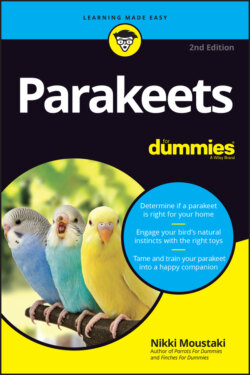Читать книгу Parakeets For Dummies - Nikki Moustaki - Страница 25
One, Two — or More: Increasing Your Parakeet Population
ОглавлениеIf you want a sweet parakeet that lives for seeing you come home every day, a parakeet who is so enamored with you that you can barely move without it stuck to you like a burr, you’ll want to have one — and only one — parakeet. If you get a pair of parakeets, they may want to interact only with each other, seeing you as an intrusion in their birdy love.
On the other hand, if you lead a busy life and you’re not home for many hours of the day, you may want to consider getting a pair.
Just because you have a pair, or more, does not mean that your parakeets will not become hand-tamed or won’t love you, but you may have to work a little harder to get them to see you as one of the gang.
A single parakeet, especially a single male, is more likely to talk. This doesn’t mean that birds in a pair won’t ever talk; it just means that the likelihood of getting them to talk is lessened the more parakeets you have.
Can you have three or more parakeets in a cage? If they are all males, you have a better chance that they will get along. Although female parakeets are more likely to argue and squabble, three females can live together too if they are all housed in a very large cage, flight, or aviary at the same time. If you have a true pair, a bonded male and a female, you don’t want to add another bird unless you have a very large flight cage at least six feet in length to allow a pursued “rival” adequate space to escape, or else the existing pair may become territorial and can severely injure the “intruder,” or worse.
Two parakeets interacting can be really cute if they like each other. They will sit together and preen each other. The male will do a little mating dance, strutting up and down the perch, rapidly tapping his beak against the perch or a shiny object. They will chitter-chatter to each other. These behaviors are all ways in which parakeets communicate.
When parakeets don’t like each other, one may chase the other around the cage, not allowing the less assertive bird near the food and water dishes. One may begin to pull at the other one’s tail feathers, which will suddenly appear curled at the tip, and fight more aggressively, even drawing blood. These parakeets should be separated into two different cages and closely supervised whenever exercising outside the cage, or else let out of their cages at separate times.
